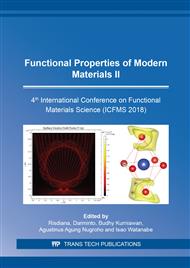[1]
L. Bao, X. Qi, Tana, L. Chao, O. Tegus, Synthesis, and magnetic and optical properties of nanocrystalline alkaline-earth hexaborides, Cryst. Eng. Comm. 18 (2016) 1223-1229.
DOI: 10.1039/c5ce02060c
Google Scholar
[2]
P.O. Lehtinen, A.V. Krasheninnikov, A.S. Foster, R.M. Nieminen, 16 - The Magnetic Nature of Intrinsic and Irradiation-induced Defects in Carbon Systems A2 - Makarova, Tatiana, in: F. Palacio (Ed.) Carbon Based Magnetism, Elsevier, Amsterdam, 2006, pp.371-396.
DOI: 10.1016/b978-044451947-4/50017-7
Google Scholar
[3]
A. Oshiyama, S. Okada, 14 - Magnetism in Nanometer-scale Materials that Contain No Magnetic Elements A2 - Makarova, Tatiana, in: F. Palacio (Ed.) Carbon Based Magnetism, Elsevier, Amsterdam, 2006, pp.329-352.
DOI: 10.1016/b978-044451947-4/50015-3
Google Scholar
[4]
S.A. Chambers, T.C. Droubay, C.M. Wang, K.M. Rosso, S.M. Heald, D.A. Schwartz, K.R. Kittilstved, D.R. Gamelin, Ferromagnetism in oxide semiconductors, Mater. Today, 9 (2006) 28-35.
DOI: 10.1016/s1369-7021(06)71692-3
Google Scholar
[5]
A. Sundaresan, R. Bhargavi, N. Rangarajan, U. Siddesh, C.N.R. Rao, Ferromagnetism as a universal feature of nanoparticles of the otherwise nonmagnetic oxides, Phys. Rev. B, 74 (2006) 161306.
DOI: 10.1103/physrevb.74.161306
Google Scholar
[6]
G.M. De Luca, G. Ghiringhelli, M. Moretti Sala, S. Di Matteo, M.W. Haverkort, H. Berger, V. Bisogni, J.C. Cezar, N.B. Brookes, M. Salluzzo, Weak magnetism in insulating and superconducting cuprates, Phys. Rev. B, 82 (2010) 214504.
DOI: 10.1103/physrevb.82.214504
Google Scholar
[7]
M. Gasmi, S. Khene, G. Fillion, Coexistence of superconductivity and ferromagnetism in nanosized YBCO powders, J. Phys. Chem. Solids, 74 (2013) 1414-1418.
DOI: 10.1016/j.jpcs.2013.04.025
Google Scholar
[8]
S.K. Hasanain, N. Akhtar, A. Mumtaz, Particle size dependence of the superconductivity and ferromagnetism in YBCO nanoparticles, J. Nanopart. Res. 13 (2011) 1953-1960.
DOI: 10.1007/s11051-010-9947-9
Google Scholar
[9]
Shipra, A. Gomathi, A. Sundaresan, C.N.R. Rao, Room-temperature ferromagnetism in nanoparticles of superconducting materials, Solid State Comm. 142 (2007) 685-688.
DOI: 10.1016/j.ssc.2007.04.041
Google Scholar
[10]
J. Cervenka, M.I. Katsnelson, C.F.J. Flipse, Room-temperature ferromagnetism in graphite driven by two-dimensional networks of point defects, Nat. Phys. 5 (2009) 840-844.
DOI: 10.1038/nphys1399
Google Scholar
[11]
W. Fan, L.-J. Zou, Z. Zeng, Ferromagnetism on surface of YBa2Cu3O7 particle, Physica C, 492 (2013) 80-89.
DOI: 10.1016/j.physc.2013.06.003
Google Scholar
[12]
A. Sundaresan, C.N.R. Rao, Ferromagnetism as a universal feature of inorganic nanoparticles, Nano Today, 4 (2009) 96-106.
DOI: 10.1016/j.nantod.2008.10.002
Google Scholar
[13]
F. Moraes, Enhancement of the Magnetic Moment of the Electron due to A Topological Defect, Mod. Phys. Lett. A, 10 (1995) 2335-2338.
DOI: 10.1142/s0217732395002490
Google Scholar
[14]
H. Arabi, S. Jamshidi, M. Komeili, A. Amirabadizadeh, Coexistence of Superconductivity and Ferromagnetic Phases in YBa2Cu3O7−δ Nanoparticles, J. Supercond. Nov. Magn. 26 (2013) 2069-2071.
DOI: 10.1007/s10948-012-1859-8
Google Scholar
[15]
M.A. Baqiya, H. Widodo, L. Rochmawati, Darminto, T. Adachi, Y. Koike, Ferromagnetism in 2212 phase Bi-Sr-Ca-Cu-O nano-superconductors, AIP Conf. Proc. 1454 (2012) 260-263.
DOI: 10.1063/1.4730735
Google Scholar
[16]
M.A. Baqiya, P.E.D. Putra, B. Triono, R. Irfanita, S. Suasmoro, D. Darminto, T. Kawamata, T. Noji, H. Sato, M. Kato, Y. Koike, Ce-Doping and Reduction Annealing Effects on Magnetic Properties of Pr2-xCexCuO4 Nanoparticles, J. Supercond Nov. Magn. (2018).
DOI: 10.1007/s10948-018-4941-z
Google Scholar
[17]
P. Fournier, T' and infinite-layer electron-doped cuprates, Physica C, 514 (2015) 314-338.
DOI: 10.1016/j.physc.2015.02.036
Google Scholar
[18]
T. Adachi, A. Takahashi, K.M. Suzuki, M.A. Baqiya, T. Konno, T. Takamatsu, M. Kato, I. Watanabe, A. Koda, M. Miyazaki, R. Kadono, Y. Koike, Strong Electron Correlation behind the Superconductivity in Ce-Free and Ce-Underdoped High-Tc T'-Cuprates, J. Phys. Soc. Jpn. 85 (2016) 114716.
DOI: 10.7566/jpsj.85.114716
Google Scholar
[19]
M.A. Baqiya, B. Triono, Darminto, T. Adachi, A. Takahashi, T. Konno, M. Watanabe, T. Prombood, Y. Koike, Protected Vacuum Annealing Effect on Single Crystals of Pr1-xLaCex CuO4 in the Overdoped Regime, IOP Conf. Ser.: Mater. Sci. Eng. 196 (2017) 012011.
DOI: 10.1088/1757-899x/196/1/012011
Google Scholar
[20]
O. Matsumoto, A. Utsuki, A. Tsukada, H. Yamamoto, T. Manabe, M. Naito, Superconductivity in undoped T'-RE2CuO4 with Tc over 30K, Physica C, 468 (2008) 1148-1151.
DOI: 10.1016/j.physc.2008.05.019
Google Scholar
[21]
M. Matsuda, Y. Endoh, Y. Hidaka, Crystal growth and characterization of Pr2−xCexCuO4, Physica C, 179 (1991) 347-352.
DOI: 10.1016/0921-4534(91)92180-j
Google Scholar
[22]
H. Rietveld, A profile refinement method for nuclear and magnetic structures, J. Appl. Crystallogr. 2 (1969) 65-71.
Google Scholar
[23]
L. Lutterotti, P. Scardi, Simultaneous structure and size-strain refinement by the Rietveld method, J. Appl. Crystallogr. 23 (1990) 246-252.
DOI: 10.1107/s0021889890002382
Google Scholar
[24]
T. Uzumaki, K. Hashimoto, N. Kamehara, Raman scattering and X-ray diffraction study in layered cuprates, Physica C, 202 (1992) 175-187.
DOI: 10.1016/0921-4534(92)90310-9
Google Scholar
[25]
P. Richard, M. Poirier, S. Jandl, P. Fournier, Impact of the reduction process on the long-range antiferromagnetism in Nd1.85Ce0.15CuO4, Phys. Rev. B, 72 (2005) 184514.
Google Scholar
[26]
H.J. Kang, P. Dai, B.J. Campbell, P.J. Chupas, S. Rosenkranz, P.L. Lee, Q. Huang, S. Li, S. Komiya, Y. Ando, Microscopic annealing process and its impact on superconductivity in T'-structure electron-doped copper oxides, Nat. Mater. 6 (2007) 224.
DOI: 10.1038/nmat1847
Google Scholar
[27]
H.S. Hsu, J.C.A. Huang, Y.H. Huang, Y.F. Liao, M.Z. Lin, C.H. Lee, J.F. Lee, S.F. Chen, L.Y. Lai, C.P. Liu, Evidence of oxygen vacancy enhanced room-temperature ferromagnetism in Co-doped ZnO, Appl. Phys. Lett. 88 (2006) 242507.
DOI: 10.1063/1.2212277
Google Scholar
[28]
S. Batakrushna, P.K. Giri, D. Soumen, I. Kenji, F. Minoru, Oxygen vacancy-mediated enhanced ferromagnetism in undoped and Fe-doped TiO 2 nanoribbons, J. Phys. D: Appl. Phys. 47 (2014) 235304.
DOI: 10.1088/0022-3727/47/23/235304
Google Scholar
[29]
R. Irfanita, P.E.D. Putra, T. Bambang, S. Chatree, K. Krongthong, M.A. Baqiya, Darminto, Oxygen Reduction Effect on T'-Pr2-xCexCuO4 Nanopowders in the Underdoped Regime Studied by X-Ray Absorption near Edge Structure, Mater. Sci. Forum, 936 (2018) 93-97.
DOI: 10.4028/www.scientific.net/msf.936.93
Google Scholar


